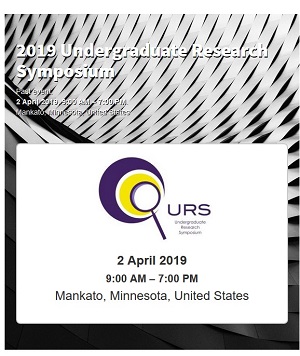Subcellular Localization of PolyQ Protein FAM171B
Location
CSU Ballroom
Start Date
2-4-2019 10:00 AM
End Date
2-4-2019 11:30 AM
Student's Major
Biological Sciences
Student's College
Science, Engineering and Technology
Mentor's Name
Geoffrey Goellner
Mentor's Department
Biological Sciences
Mentor's College
Science, Engineering and Technology
Description
Huntington's Disease, along with eight other chronic neurodegenerative diseases, is characterized by a polyQ gene mutation that results in a protein with a long tract of repeating glutamine (Q) amino acids. Typical symptoms of these diseases include involuntary movements, loss of balance, and loss of cognitive functions. PolyQ mutations are strongly implicated in neurodegenerative disease due to their absence from healthy animal models. A novel protein, known as FAM171B, has been selected for investigation by our lab due to its strong potential for polyQ mutations and ubiquitous expression in brain cells. Transfection and immunofluorescence (IF) procedures were utilized to begin identifying FAM171B's subcellular location in U-138 immortal glioblastoma cells. DNA plasmids containing GFP-tagged FAM171B prepared in our lab were introduced to live cells using Lipofectamine 2000 (ThermoFischer) reagent and its transfection protocol. IF experiments utilized rabbit-α-FAM171B primary antibodies and goat-α-rabbit (Alexa488) secondary antibodies to identify naturally-expressed FAM171B proteins within methanol-fixed cells. DAPI was used in both procedures to identify the nucleus of each cell. Data from recent experiments suggest FAM171B is either expressed in the nucleus or in the cytoplasm, specifically around the nucleus and along neuronal processes, of U-138 cells. Expression of FAM171B in both the nucleus and cytoplasm informs current and future research by our lab which aims to identify FAM171B's interactions with known intracellular proteins. Determining FAM171B's subcellular location will not only give us an understanding of the protein's normal function, but will also give us a better understanding of polyQ neurodegenerative diseases as a whole.
Subcellular Localization of PolyQ Protein FAM171B
CSU Ballroom
Huntington's Disease, along with eight other chronic neurodegenerative diseases, is characterized by a polyQ gene mutation that results in a protein with a long tract of repeating glutamine (Q) amino acids. Typical symptoms of these diseases include involuntary movements, loss of balance, and loss of cognitive functions. PolyQ mutations are strongly implicated in neurodegenerative disease due to their absence from healthy animal models. A novel protein, known as FAM171B, has been selected for investigation by our lab due to its strong potential for polyQ mutations and ubiquitous expression in brain cells. Transfection and immunofluorescence (IF) procedures were utilized to begin identifying FAM171B's subcellular location in U-138 immortal glioblastoma cells. DNA plasmids containing GFP-tagged FAM171B prepared in our lab were introduced to live cells using Lipofectamine 2000 (ThermoFischer) reagent and its transfection protocol. IF experiments utilized rabbit-α-FAM171B primary antibodies and goat-α-rabbit (Alexa488) secondary antibodies to identify naturally-expressed FAM171B proteins within methanol-fixed cells. DAPI was used in both procedures to identify the nucleus of each cell. Data from recent experiments suggest FAM171B is either expressed in the nucleus or in the cytoplasm, specifically around the nucleus and along neuronal processes, of U-138 cells. Expression of FAM171B in both the nucleus and cytoplasm informs current and future research by our lab which aims to identify FAM171B's interactions with known intracellular proteins. Determining FAM171B's subcellular location will not only give us an understanding of the protein's normal function, but will also give us a better understanding of polyQ neurodegenerative diseases as a whole.
Recommended Citation
Almeer, Farah and Alaina Oakley. "Subcellular Localization of PolyQ Protein FAM171B." Undergraduate Research Symposium, Mankato, MN, April 2, 2019.
https://cornerstone.lib.mnsu.edu/urs/2019/poster-session-A/12



